
C H I P S T O N E
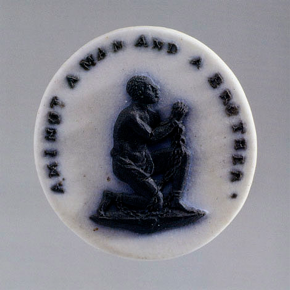
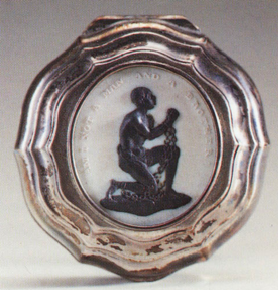
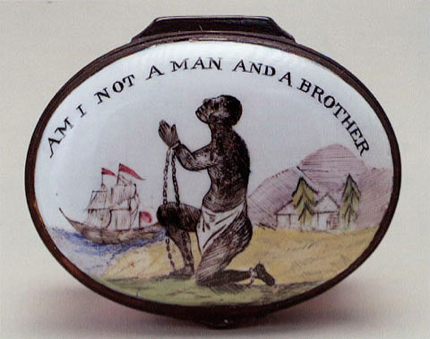
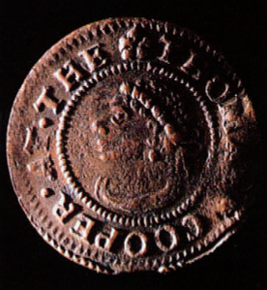
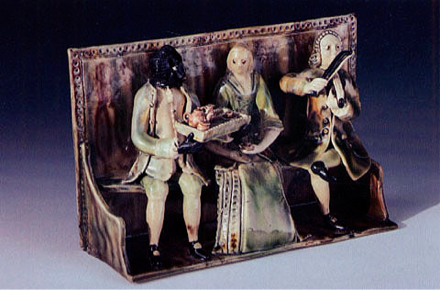
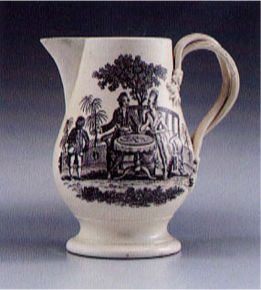
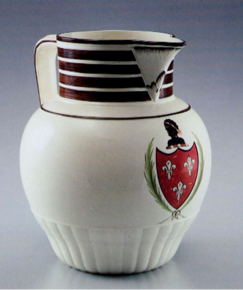
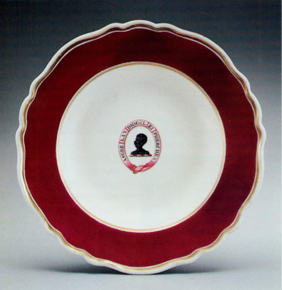
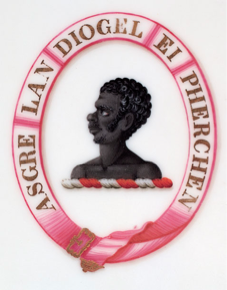
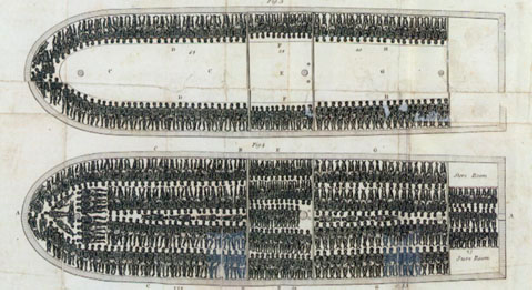
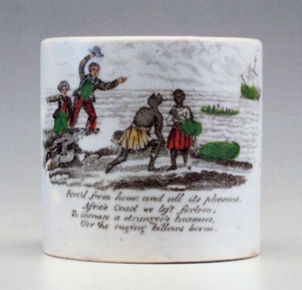
Sam Margolin
“And Freedom to the Slave”: Antislavery Ceramics, 1787–1865
Ceramics in America, 2002
Figures
Figure 1 Medallion, Josiah Wedgwood,
Staffordshire, England, ca. 1787.
Jasperware. D. 1 1/8". (Chipstone
Foundation; photo, Gavin Ashworth.)
Design of chained and kneeling slave in
profile taken from the seal of the Society
for the Abolition of the Slave Trade.
Staffordshire, England, ca. 1787.
Jasperware. D. 1 1/8". (Chipstone
Foundation; photo, Gavin Ashworth.)
Design of chained and kneeling slave in
profile taken from the seal of the Society
for the Abolition of the Slave Trade.
Figure 2 Medallion, Josiah Wedgwood,
Staffordshire, England, ca. 1787.
Jasperware and silver. D. 1 7/8".
(Collection of Rex Stark; photo, Gavin
Ashworth.)
Staffordshire, England, ca. 1787.
Jasperware and silver. D. 1 7/8".
(Collection of Rex Stark; photo, Gavin
Ashworth.)
Figure 3 Patch box, England, ca. 1800. Painted
enamel on metal. L. 1 3/4". (Collection of Rex
Stark; photo, Gavin Ashworth.)
enamel on metal. L. 1 3/4". (Collection of Rex
Stark; photo, Gavin Ashworth.)
Figure 4 Halfpenny token, 1668.
Copper. D. 7/8". (Collection of the
author; photo, Gavin Ashworth.) Head
of black youth representing the Black
Boy Pub.
Copper. D. 7/8". (Collection of the
author; photo, Gavin Ashworth.) Head
of black youth representing the Black
Boy Pub.
Figure 5 Figural group, Staffordshire England, ca. 1760.
Creamware. H. 5 3/8". (Courtesy, Colonial Williamsburg
Foundation.)
Creamware. H. 5 3/8". (Courtesy, Colonial Williamsburg
Foundation.)
Figure 6 Cream jug, Staffordshire or
Yorkshire, England, 1780–1790.
Creamware. H. 4 1/2". (Collection of
the author; photo, Gavin Ashworth.)
This jug, part of a larger tea service,
has twisted strap handles with
molded sprigs terminals and a black
transfer print of The Tea Party.
Yorkshire, England, 1780–1790.
Creamware. H. 4 1/2". (Collection of
the author; photo, Gavin Ashworth.)
This jug, part of a larger tea service,
has twisted strap handles with
molded sprigs terminals and a black
transfer print of The Tea Party.
Figure 7 Jug, England, ca. 1800.
Pearlware. H. 9 1/2". (Collection
of the author; photo, Gavin
Ashworth.) Armorial crest
featuring blackamoor bust in
profile.
Pearlware. H. 9 1/2". (Collection
of the author; photo, Gavin
Ashworth.) Armorial crest
featuring blackamoor bust in
profile.
Figure 8 Detail of the crest illustrated
in figure 7.
in figure 7.
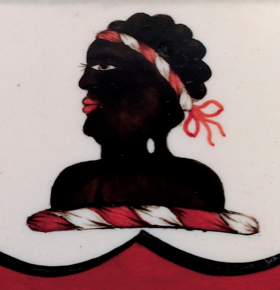
Figure 9 Soup plate, France, ca.
1810. Porcelain. D. 9 3/4". (Collection
of the author; photo, Gavin
Ashworth.) Blackamoor head and
legend “Asgre
1810. Porcelain. D. 9 3/4". (Collection
of the author; photo, Gavin
Ashworth.) Blackamoor head and
legend “Asgre
Lan Diogel ei Pherchen.”
Figure 10 Detail of the soup
plate illustrated in fig. 9. The
Latin legend translates as “A
pure conscience is a safeguard
to its possessor.”
plate illustrated in fig. 9. The
Latin legend translates as “A
pure conscience is a safeguard
to its possessor.”
Figure 11 Detail of an engraving, from Thomas Clarkson’s History of the
Abolition of the African Slave Trade, London, 1807. Influential figures such
as Thomas Clarkson were given the responsibility of collecting information
to support the abolition of the slave trade. This included interviewing
20,000 sailors and obtaining equipment used on the slave ships such as
iron handcuffs, leg-shackles, thumb screws, instruments for forcing open
slaves’ jaws, and branding irons. In 1787 he published his pamphlet, A
Summary View of the Slave Trade and of the Probable Consequences of Its
Abolition. After the abolishment of the British slave trade in 1807, Clarkson
published his book History of the Abolition of the African Slave Trade.
Abolition of the African Slave Trade, London, 1807. Influential figures such
as Thomas Clarkson were given the responsibility of collecting information
to support the abolition of the slave trade. This included interviewing
20,000 sailors and obtaining equipment used on the slave ships such as
iron handcuffs, leg-shackles, thumb screws, instruments for forcing open
slaves’ jaws, and branding irons. In 1787 he published his pamphlet, A
Summary View of the Slave Trade and of the Probable Consequences of Its
Abolition. After the abolishment of the British slave trade in 1807, Clarkson
published his book History of the Abolition of the African Slave Trade.
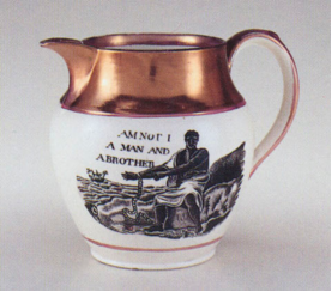
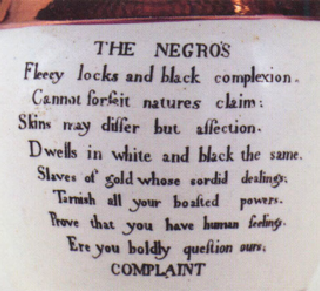
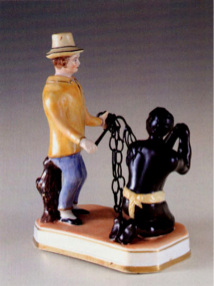
Figure 12 Child’s mug, England, ca. 1840.
Whiteware. H. 2 1/2". (Collection of Rex
Stark; photo, Gavin Ashworth.) This
enamel-colored black transfer print
depicts the capture of native Africans by
European slavers, along with the opening
verse from William Cowper’s The Negro’s
Complaint: “Forcd from home and all its
pleasures/Afric’s coast we left forlorn/To
increase a stranger’s treasures/O’er the
raging billows borne.”
Whiteware. H. 2 1/2". (Collection of Rex
Stark; photo, Gavin Ashworth.) This
enamel-colored black transfer print
depicts the capture of native Africans by
European slavers, along with the opening
verse from William Cowper’s The Negro’s
Complaint: “Forcd from home and all its
pleasures/Afric’s coast we left forlorn/To
increase a stranger’s treasures/O’er the
raging billows borne.”
Figure 13 Jug, Staffordshire or Sunderland, ca.
1820. Pearlware. H. 4 1/2". (Collection of Rex
Stark; photo Gavin Ashworth.) This jug with
copper and pink luster trim shows a transfer-
printed variation of the Wedgwood plaque
design. This one features a frontal view of a
chained and seated slave, and verses from
William Cowper’s The Negro’s Complaint on the
other side. Note the reversal, most likely
unintentional, of “I” and “Not” in the printed
motto.
1820. Pearlware. H. 4 1/2". (Collection of Rex
Stark; photo Gavin Ashworth.) This jug with
copper and pink luster trim shows a transfer-
printed variation of the Wedgwood plaque
design. This one features a frontal view of a
chained and seated slave, and verses from
William Cowper’s The Negro’s Complaint on the
other side. Note the reversal, most likely
unintentional, of “I” and “Not” in the printed
motto.
Figure 14 Detail of the reverse of the jug
illustrated in fig. 13. This stanza from The
Negro’s Complaint reads (italics mine):
“Slaves of gold, whose sordid dealings/
Tarnish all your boasted powers,/Prove that
you have human feelings/Ere you proudly
question ours!”
illustrated in fig. 13. This stanza from The
Negro’s Complaint reads (italics mine):
“Slaves of gold, whose sordid dealings/
Tarnish all your boasted powers,/Prove that
you have human feelings/Ere you proudly
question ours!”
Figure 15 Figural group, France or
England, ca. 1820. Porcelain. H. 6 1/4".
(Collection of Rex Stark; photo, Gavin
Ashworth.) A late eighteenth-century
antislavery pamphlet by William Fox
included a section on punishment in
which a Royal Navy admiral attested
that the flogging of slaves was much
more severe than that administered to
sailors aboard English men-of-war.
More explicitly, an English general
asserted “there is no comparison
between regimental flogging, which
only cuts the skin, and the plantation,
which cuts out the flesh.”
England, ca. 1820. Porcelain. H. 6 1/4".
(Collection of Rex Stark; photo, Gavin
Ashworth.) A late eighteenth-century
antislavery pamphlet by William Fox
included a section on punishment in
which a Royal Navy admiral attested
that the flogging of slaves was much
more severe than that administered to
sailors aboard English men-of-war.
More explicitly, an English general
asserted “there is no comparison
between regimental flogging, which
only cuts the skin, and the plantation,
which cuts out the flesh.”
Figure 16 Reverse view of the
figural group illustrated in fig.
15.
figural group illustrated in fig.
15.
Figure 17 Mug, England, ca. 1850.
Porcelain H. 3". (Collection of Rex Stark;
photo, Gavin Ashworth.) In elaborate gold
script: “Health to the Sick/ Honour to the
Brave/Success attend true Love/ And
Freedom to the Slave.”
Porcelain H. 3". (Collection of Rex Stark;
photo, Gavin Ashworth.) In elaborate gold
script: “Health to the Sick/ Honour to the
Brave/Success attend true Love/ And
Freedom to the Slave.”
Figure 18 Sugar bowl, England,
1820–1830. Bone china. H. 4 5/8".
(Courtesy, Colonial Williamsburg
Foundation.) The decoration of the
kneeling slave in the tropical
environment is enameled over the
glaze suggesting that it may have
been produced for a special anti-
slavery fair or occasion.
1820–1830. Bone china. H. 4 5/8".
(Courtesy, Colonial Williamsburg
Foundation.) The decoration of the
kneeling slave in the tropical
environment is enameled over the
glaze suggesting that it may have
been produced for a special anti-
slavery fair or occasion.
Figure 19 Reverse of the sugar
bowl illustrated in fig. 18. Legend
reads: “East India Sugar not
made/By Slaves/By Six families
using/East India, instead of/West
India Sugar, one/Slave less is
required.” The wording represents a
somewhat sanitized version of Fox’s
formulation that “A family that uses
5 lb. of sugar per week...will, by
abstaining from the consumption 21
months, prevent the slavery or
murder of one fellow creature” and
tactfully omits the pamphleteer’s
more gruesome analogy “that in
every pound of sugar used...we may
be considered as consuming two
ounces of human flesh.”
bowl illustrated in fig. 18. Legend
reads: “East India Sugar not
made/By Slaves/By Six families
using/East India, instead of/West
India Sugar, one/Slave less is
required.” The wording represents a
somewhat sanitized version of Fox’s
formulation that “A family that uses
5 lb. of sugar per week...will, by
abstaining from the consumption 21
months, prevent the slavery or
murder of one fellow creature” and
tactfully omits the pamphleteer’s
more gruesome analogy “that in
every pound of sugar used...we may
be considered as consuming two
ounces of human flesh.”
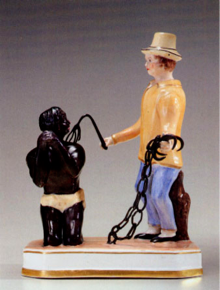
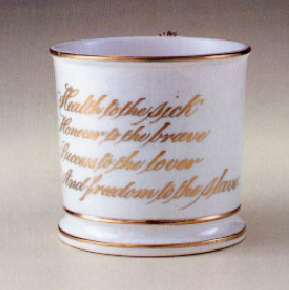
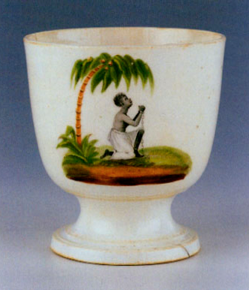
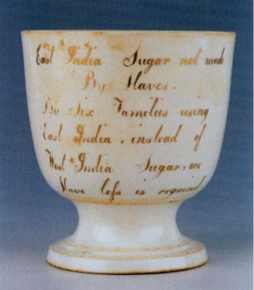
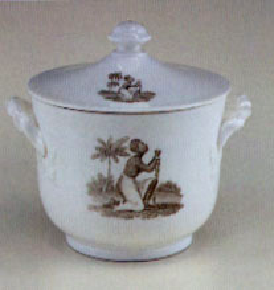
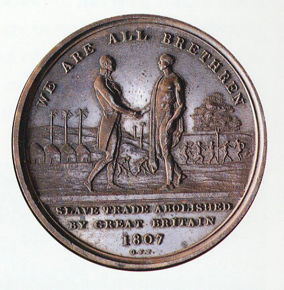
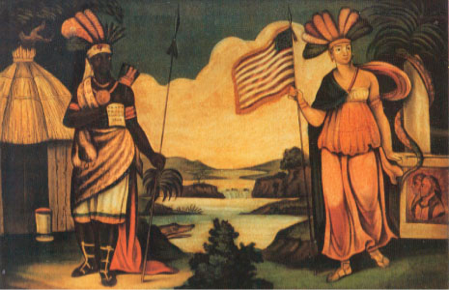
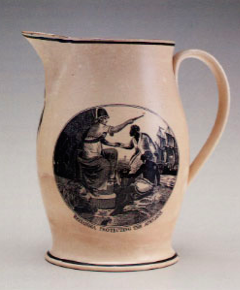
Notes:
• perhaps the captions should be
in scrolling boxes so this grid page
looks neater?
in scrolling boxes so this grid page
looks neater?
Ceramics in America 2002
Full article
Contents